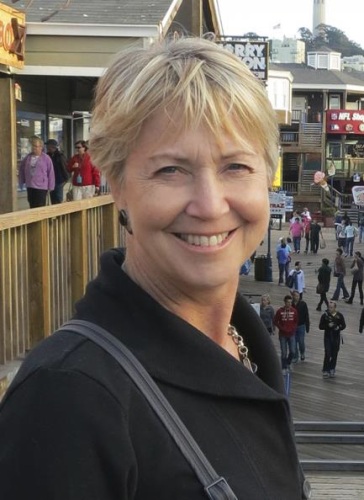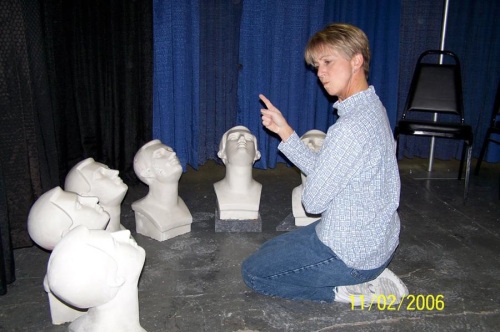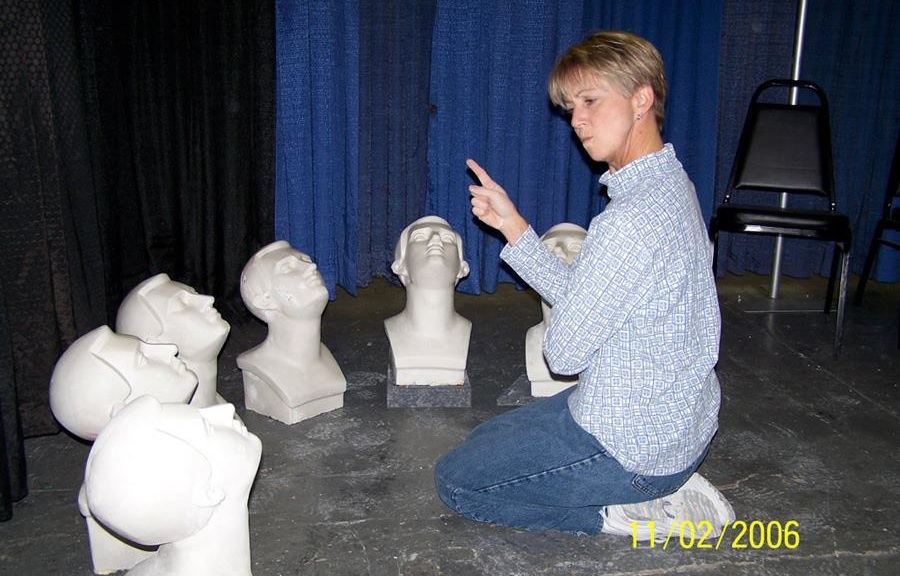The following is one of several interviews conducted by students of Ron DeMarco’s properties class at Emerson College.
Deb Morgan: One-Woman Prop Shop
by John Meredith

Deb Morgan is a freelancer who is the current Property Master at the Lyric Opera of Kansas City. She has a strong background in music that started at a young age, when she started taking dance classes and participating in music recitals in grade school. Her interest in performance continued as she took up the flute and played it in both her school band and marching band as well. During the summers of her high school years, she was part of a musical program. That is what peaked her interest in theater. All of the students in the program not only sang and acted in the show, but built props and sets as well. She loved performing, but not so much the acting, and gained awareness of the design aspects of theater.
She continued dabbling in the technical and artistic side of theater when she went to college at the University of Kansas. Following her love for art, she majored in design. She opted out of taking some of the classes she found more tedious, and took in their place classes like lighting design for the theater. She took as many theater classes as she could fit into her schedule while still getting the credits for her art degree. She was building up knowledge in a variety of theatrical and design areas. “For my final project in college,” she said, “I built a dance suit that lit up my limbs, and performed in the dark. Yeah, it was the 70’s.”
After graduating college, she moved to San Francisco. There she got a job at a film-processing lab, which she worked at during the day. However, she continued to follow her passion for theater at night, moonlighting as a dance lighting designer, and doing various other odd jobs with small theatre productions. “Turns out all those dance classes and music lessons paid off; I could learn their dance numbers pretty quickly and run the lights as well as design them.”
She moved back to Kansas City and applied to work in the lighting department at the Missouri Rep for the summer. To her dismay, they had no openings in the lighting department. However, they noted that her resume had a variety of theatrical jobs and asked if she wanted to fill the opening they had in the props department. At the time, she did not realize she could get a job doing crafts, painting, and sewing. She took the job, and at the end of the summer, they offered her a full time position as the props master. She took the job and never looked back.
She had no formal training in props, but she learned from experience. She said that the sops she worked in were full of wonderful mentors that taught her a lot. She said that, “having a love of all things crafty and artistic as well as innate organizational skills has served me well.” Her love of learning and trying new things really helped keep her motivated and excited to work. Deb’s assistant Nancy used to say that, “the first time making something is really interesting. The second time you get better at it and it takes you less time than the first. The third time making it is just plain torture!” It is exciting to explore things and make everything new, find new ways to build things. In her opinion, a good prop master has to have a little ADD to be able to be working on so many things at once and rarely have to do the same thing twice.
Deb had two assistants assigned to her department at the Missouri Rep. One assistant specialized in soft goods and the other in sculpture and carpentry. As a team, they wrestled through problems together. They bounced ideas off each other, and they all learned from one another while having “a hell of a good time.” For example in one show the designer wanted mosaic tables so they had to learn how to tile. They worked on anything from casting Greek masks to upholstering chairs and making curtains.
After working at the Missouri Rep for sixteen years, she left and became a one-woman freelance prop shop. At first, she found the transition startling, because she no longer had anyone to “boss around” and had to figure out a way to do what she did before with two assistants by herself. Over the years, she slowly converted her basement into her own shop. One section was for carpentry and the other for sewing and upholstery. She has started accumulating props, tools, and miscellaneous stuff; some that she really does use and others that she is just sure she will need some day. She says she is trying to keep all of this in the shop in the basement and not let it creep upstairs.
Most of her work after Missouri Rep has been with the Lyric Opera of Kansas City, where she has been prop master for the four shows they produce a year for the past fourteen years. This leaves her with time to pursue other jobs in between shows as well. Deb finds operas a unique experience compared to plays and musicals. Rarely is the set a three-walled structure with lots of set dressing (as you might see in plays), and she hardly ever produces anything that would have been created post 1900’s. She also says that she makes a lot more props, and everything is big! Because the voices, space, and drama (“backstage and onstage”) are all bigger than life so are the props.
She does not make puny feather dusters, she makes two-foot feather dusters that you could use to sweep snow off your front porch, and the tablecloths she makes are never shorter than six feet. She has made giant pillows by cutting up and reupholstering futon beds. She has made a bull’s head that an actor needed to dance in for a ball scene. Operas also have large choruses from twenty-five up to one-hundred people, and most of them need something in their hands. The high body count often means lots of sword fights, which can lead to lots of blood and severed heads. She even has a demonstration video on YouTube on how to make fake blood and bursting packets for “maximum gore effect.” Working with large groups of actors she said she also, “had to get proficient at making fake food because whatever real food is out there with chorus on stage – let’s just say they would eat the doilies if you don’t watch them.”
For one show, she had to build a model ship to match the giant one that was onstage, that could be thrown and break apart but be in one piece later in the show. To get the pieces to stick together she used rare earth magnets, however the tricky part was finding the right balance so that it would be strong enough to stay together but weak enough to break apart. To do this, she added layers of scrim over the magnet until she found the right balance.
Some of the hardest and most time-consuming props Deb has to make are in the casting venue. For Hamlet she had to make a head that got thrown to the ground each show and shatter (am I noticing a trend?). She did quite a lot of tests for different materials, and spent a lot of time at her local Smooth-On dealer trying out products. She came across her final result by a happy accident. The Smash Plastic she was using for slush fill within the mold kept pooling in the face and she could not keep it turning long enough to set completely. The result was a head that broke into a million pieces, that sounded and looked great, and the face always ended up in one piece. Because of that the actor was able to pick up the remaining face and sing his aria to it every night.
While making lifecasts of actors is always a challenge, Deb finds severed heads very fun to make. Though she has done enough to know how the final product should turn out, she still does not get it perfect every time. She did the severed head for Salome which had to be brought out on stage after John the Baptist is beheaded. Her friend who did the wigs and makeup helped to paint the head so that it matched the actor.

Unfortunately, Deb does not get as many messy gruesome props, as she would like because many of the costumes are rented, so keeping costumes clean is first priority. However, back in her earlier theater days she needed to make a pig’s head that squirted blood. She decided it would be a great idea of casting a real pig’s head. However, the smell of the pig’s head was so bad that she was banned from the shop and had to work outside, and the heat from the mold curing was more than even she could bear. During the show the actor pokes out the eyes and an inky looking goo is supposed to squirt all over her. Her original idea was to use disappearing ink to eliminate cleanup, however it worked to well, and the first night they tried it the ink disappeared right in front of the audience’s eyes. She ended up using a concoction of shampoos that was dark enough to read, but easily rinsed out.
Currently Deb is working on two shows: Street Scenes for the University of Missouri Conservatory of Music and La Boheme with the Lyric Opera. Normally she does not work two shows at once, however she assumed that both shows would be easy and would equal one full time job. Her advice to me, “never assume.” Although the production of La Boheme was one of Lyric’s rental packages, the director wanted many changes that she was not originally expecting.
She says that balancing two productions is tough, but it is something you will likely have to do at least once. It takes a lot of organization, time management, and prioritizing to make it through. Deb takes all of her notes and prioritizes which things she needs to do first and how badly each production needs them. She also lists what she is actually going to be able to accomplish in a day. In the morning, she would work in the brand new facilities (scene shop, costume shop, paint shop, all in one building) at the Lyric Opera. Then she would go to the Conservatory in the afternoon, which had classes in them for most of the day. The week they both got to tech was one of the most stressful weeks she has had, but you just need to stay calm and find a way to relieve that stress. For her that was her husband and her dog. And sleep, never skimp on sleep or you will not be able to function the next day.
As a freelancer, she has the opportunity to try new things like commercials, photo shoots, and even a movie (Mr. and Mrs. Bridge). There is a huge difference between commercial work and theater, she says. A committee of the director, client, producers, and art director decides the looks of props for live commercials. Because of that instead of having one or two options for a prop, it’s better to bring in five just in case. The time is also much more intense. It’s a shorter period of time, but day rates are based on 10-hour days, and on shoot days 14-16 hour days are the norm. Still photo shoots on the other hand are often calmer. For an outdoor shot of a tailgating party, after a day of shipping she showed up at 5pm set everything up, and was home by 9 o’clock.
Though she enjoyed the experience of working in these different settings, overall she preferred the lengthier process of theater, “the time to figure problems out, and the time to work on a production.” She also loves the payoff of opening night and hearing the audience’s reaction, and enjoying how all of the work comes together to create a performance. Her final advice was her motto “Will it be fun?” You need to remember that this is a job you love, and that if you are too busy stressing about how tired you are or how you can hardly wait until the show is over, you are not really living life to the fullest.






I have had the opportunity to have Deb Morgan judge my work at the Kennedy Center American College Theatre Festival. She graciously awarded me with the prop design of the year in 2012. From then on I have been inspired to prove that I can design and build props.
Thank you Deb for you support even after the Theatre Festival, and thank you for pushing me to go further. With out your help I would not have become a props intern at Perseverance Theatre!